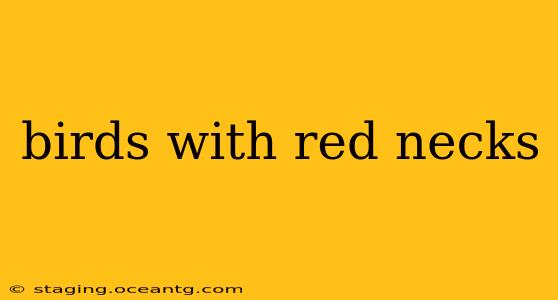Many bird species boast stunning red necks, making identification a fascinating challenge for birdwatchers. This vibrant plumage often plays a crucial role in courtship displays, territorial defense, and camouflage. Let's explore some of the birds sporting this striking feature, delving into their habitats, behaviors, and unique characteristics. This guide will help you confidently identify these beautiful creatures in the wild.
What are some birds with red necks?
Several bird families feature species with red necks, ranging across various continents and habitats. Some common examples include:
- Northern Cardinal (Cardinalis cardinalis): This iconic North American bird is instantly recognizable with its bright red plumage, including its distinctive red face and neck. Males exhibit this coloration more intensely than females.
- Red-necked Phalarope (Phalaropus lobatus): This small shorebird displays a striking red neck during breeding season. The intensity of the red varies, offering a useful identification marker.
- Red-necked Grebe (Podiceps grisegena): This diving bird features a rich chestnut-red neck, especially noticeable during breeding season. Its plumage helps it blend seamlessly into its aquatic environment.
- Red-necked Woodpecker (Campethera nuchalis): Found in Africa, this woodpecker exhibits a red nape and neck, adding to its already vibrant appearance.
- Red-necked Stint (Calidris ruficollis): A small sandpiper, this bird's red neck is a key characteristic, particularly prominent during its breeding season.
- Red-breasted Sapsucker (Sphyrapicus ruber): While primarily known for its red breast, this woodpecker also displays a red patch on its neck.
What causes the red color in birds' necks?
The brilliant red coloration in the necks of these birds comes from pigments called carotenoids. These pigments are obtained from the birds' diet, typically from consuming plants and insects rich in carotenoids. The bird's ability to metabolize and deposit these pigments in its feathers determines the intensity and vibrancy of the red color. Therefore, the richness of the red can sometimes reflect the bird's health and diet.
What is the significance of the red neck in bird behavior?
The red neck often plays a vital role in bird behavior, primarily in:
- Sexual Selection: The vibrant red coloration is often a key trait in attracting mates. Brighter, more intense red necks can signal better health and genetic quality to potential partners.
- Territorial Defense: The conspicuous red neck can also serve as a warning signal to other males, indicating dominance and ownership of a territory. The display of the red neck can deter rivals and reduce the need for physical conflict.
- Camouflage: In some species, the red neck may help in camouflage, blending into specific environmental features.
How can I identify a bird with a red neck?
Identifying a bird with a red neck requires careful observation and attention to detail. Consider these factors:
- Shape and size of the red patch: Is it a complete neck ring, a partial patch, or a more diffuse reddish wash?
- Overall plumage: What are the colors of the rest of the bird's body?
- Habitat: Where were you observing the bird? Different species prefer different habitats.
- Behavior: What was the bird doing? Was it foraging, singing, or displaying?
- Geographical location: Knowing your location helps narrow down the possibilities. Use a reliable field guide specific to your region.
Are there any other birds with similar coloring?
Yes, some birds might exhibit reddish hues on their throat or breast that could initially be mistaken for a red neck. Careful examination of the plumage pattern and overall appearance is crucial to avoid misidentification. For instance, some woodpeckers have red markings on their heads and faces, which require close observation to differentiate. Reliable bird identification guides and online resources are invaluable tools.
By understanding the factors influencing the red neck coloration and behavioral significance, you can enhance your birdwatching skills and appreciate the intricate beauty of these fascinating avian species. Happy birding!
